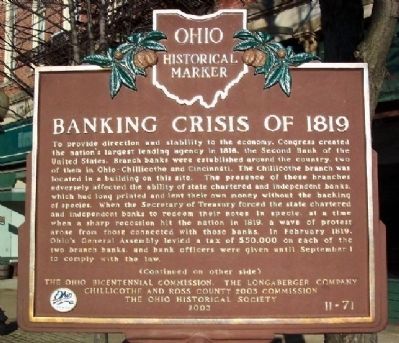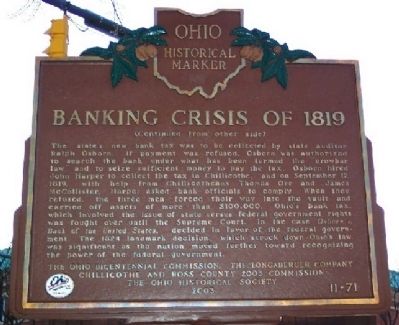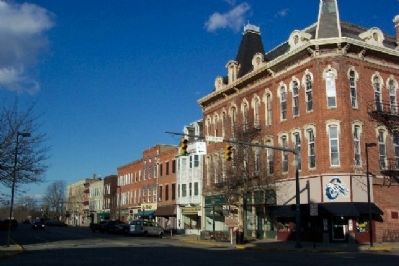Chillicothe in Ross County, Ohio — The American Midwest (Great Lakes)
Banking Crisis of 1819
To provide direction and stability to the economy, Congress created the nation's largest lending agency in 1816, the Second Bank of the United States. Branch banks were established around the country, two of them in Ohio-Chillicothe and Cincinnati. The Chillicothe branch was located in a building on this site. The presence of these branches adversely affected the ability of state chartered and independent banks, which had long printed and lent their own money without the backing of species. When the Secretary of Treasury forced the state chartered and independent banks to redeem their notes in specie, at a time when a sharp recession hit the nation in 1819, a wave of protest arose from those connected with those banks. In February 1819, Ohio's General Assembly levied a tax of $50,000 on each of the two branch banks, and bank officers were given until September 1 to comply with the law.
[Marker Reverse]:
The state's new bank tax was to be collected by state auditor Ralph Osborn. If payment was refused, Osborn was authorized to search the bank under what has been termed the “crowbar law” and to seize sufficient money to pay the tax. Osborn hired John Harper to collect the tax in Chillicothe, and on September 17, 1819, with help from Chillicotheans Thomas Orr and James McCollister, Harper asked bank officials to comply. When they refused, the three men forced their way into the vault and carried off assets of more than $100,000. Ohio's bank tax, which involved the issue of state versus federal government rights was fought over until the Supreme Court, in the case Osborn v. Bank of the United States, decided in favor of the federal government. The 1824 landmark decision, which struck down Ohio's law, was significant as the nation moved further toward recognizing the power of the federal government.
Erected 2003 by Ohio Bicentennial Commission, The Longaberger Company, Chillicothe and Ross County 2003 Commission, and The Ohio Historical Society. (Marker Number 11-71.)
Topics and series. This historical marker is listed in these topic lists: Government & Politics • Industry & Commerce • Notable Events. In addition, it is included in the Ohio Historical Society / The Ohio History Connection series list. A significant historical date for this entry is September 17, 1819.
Location. 39° 20.08′ N, 82° 58.939′ W. Marker is in Chillicothe, Ohio, in Ross County. Marker is at the intersection of Paint Street and 2nd Street, on the right when traveling west on Paint Street. Touch for map. Marker is in this post office area: Chillicothe OH 45601, United States of America. Touch for directions.
Other nearby markers. At least 8 other markers are within walking distance of this marker. The First Statehouse (about 400 feet away, measured in a direct line); Ross County Revolutionary War Memorial (about 400 feet away); Chillicothe (about 400 feet away); War Savings Stamps (about 500 feet away); Nathaniel Massie (about 500 feet away); Site of Ohio's First Statehouse (about 500 feet away); The "Statehood Riots" / The Enabling Act 1802 (about 500 feet away); Veterans Memorial (about 500 feet away). Touch for a list and map of all markers in Chillicothe.
Credits. This page was last revised on March 7, 2021. It was originally submitted on December 23, 2008, by William Fischer, Jr. of Scranton, Pennsylvania. This page has been viewed 1,163 times since then and 43 times this year. Photos: 1, 2, 3. submitted on December 23, 2008, by William Fischer, Jr. of Scranton, Pennsylvania. • Kevin W. was the editor who published this page.


